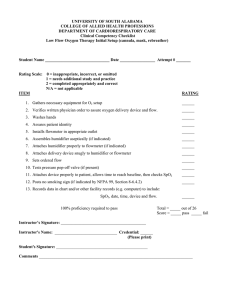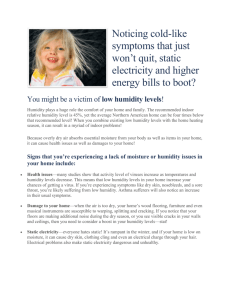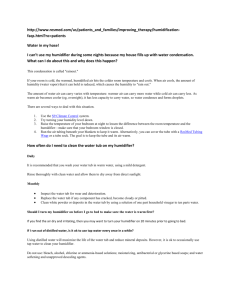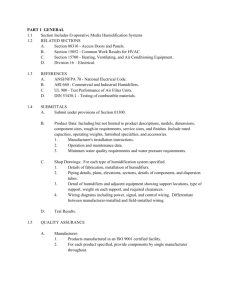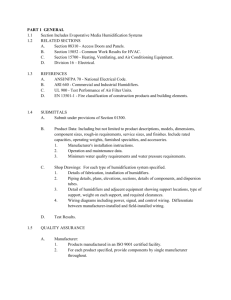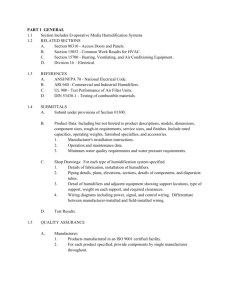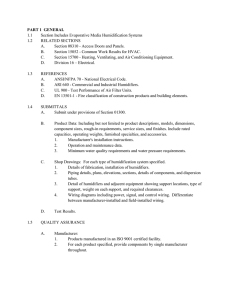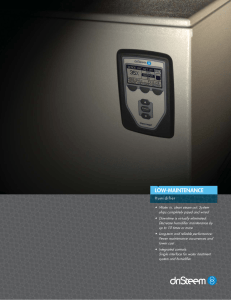AHRI Guideline F
advertisement
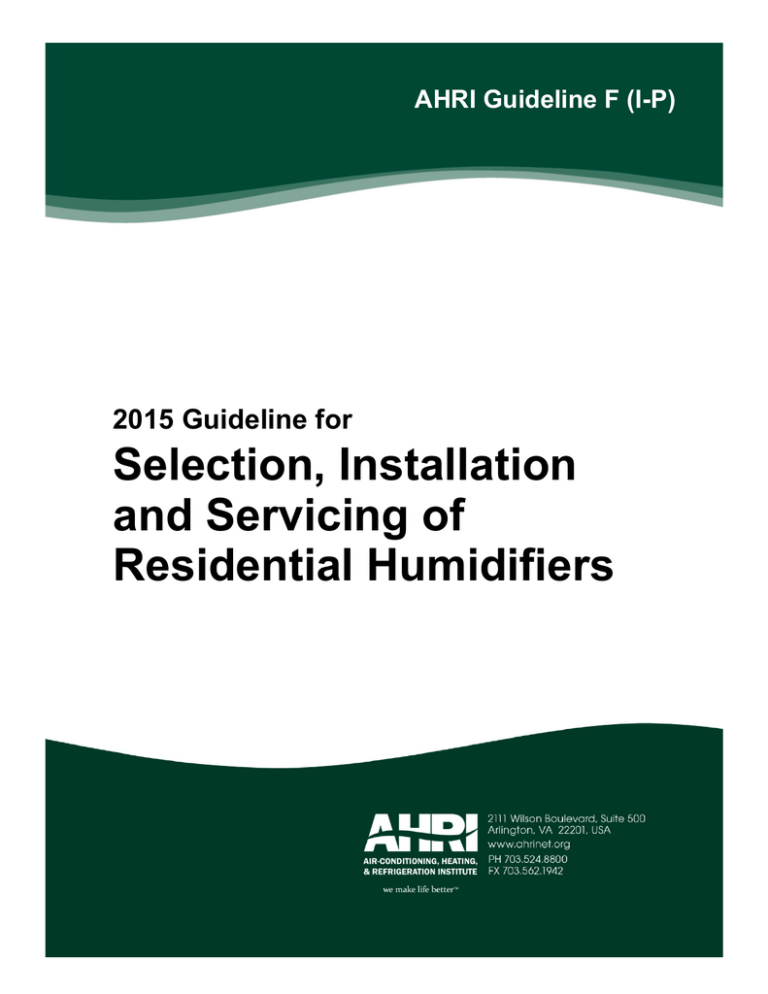
AHRI Guideline F (I-P) 2015 Guideline for Selection, Installation and Servicing of Residential Humidifiers IMPORTANT SAFETY DISCLAIMER AHRI does not set safety standards and does not certify or guarantee the safety of any products, components or systems designed, tested, rated, installed or operated in accordance with this standard/guideline. It is strongly recommended that products be designed, constructed, assembled, installed and operated in accordance with nationally recognized safety standards and code requirements appropriate for products covered by this standard/guideline. AHRI uses its best efforts to develop standards/guidelines employing state-of-the-art and accepted industry practices. AHRI does not certify or guarantee that any tests conducted under its standards/guidelines will be nonhazardous or free from risk. Note: This guideline supersedes AHRI Guideline F-2008. For SI ratings, see AHRI Guideline F (SI) – 2015. Price $10.00 (M) $20.00 (NM) Printed in U.S.A. ©Copyright 2015, by Air-Conditioning, Heating, and Refrigeration Institute Registered United States Patent and Trademark Office TABLE OF CONTENTS SECTION PAGE Section 1. Purpose..............................................................................................................................1 Section 2. Scope .................................................................................................................................1 Section 3. Definitions.........................................................................................................................1 Section 4. Factors Affecting Humidification Load ............................................................................2 Section 5. Humidification Load Determination .................................................................................3 Section 6. Residential Humidifier Selection ......................................................................................6 Section 7. Installation Best Practices .................................................................................................8 Section 8. Servicing Best Practices ..................................................................................................10 TABLES Table 1. Humidification Load Required, gal/day.............................................................................4 Table 2. Correction Factor for Other Indoor Temperatures and RH Conditions ............................4 Table 3. Selection Based on Water Types and Hardness ................................................................6 APPENDICES Appendix A. References – Normative ..................................................................................................11 Appendix B. References – Informative ................................................................................................11 Appendix C. Periodic Maintenance Checklist – Informative...............................................................12 AHRI GUIDELINE F-2015 (I-P) SELECTION, INSTALLATION AND SERVICING OF RESIDENTIAL HUMIDIFIERS Section 1. Purpose 1.1 Purpose. The purpose of this guideline is to establish, for residential Humidifiers: definitions; factors affecting Humidification Loads; determination of Humidification Load; equipment selection; installation practices; and servicing practices. 1.1.1 Intent. This guideline is intended for the guidance of the industry, including manufacturers, engineers, installers, contractors and users. 1.1.2 Review and Amendment. This guideline is subject to review and amendment as technology advances. Section 2. Scope 2.1 Scope. This guideline applies to Central System and Self-contained Humidifiers, as defined in AHRI Standards 610 (I-P) and 620 (I-P), installed in residential and small commercial applications. Section 3. Definitions All terms in this document will follow the standard industry definitions in the ASHRAE Terminology Site (https://www.ashrae.org/resources--publications/free-resources/ashrae-terminology) unless otherwise defined in this section. 3.1 Humidifier. A device used to add moisture to the air. 3.1.1 Central System Humidifier. A type of Humidifier that adds moisture to the air stream of a central air system. It may be mounted in or on the following: 3.1.1.1 3.1.1.2 3.1.1.3 3.1.1.4 3.1.1.5 3.1.1.6 Return air duct Return air plenum Supply air duct Supply air plenum By-pass (supply to return) Heating or cooling central air system 3.1.2 Self-contained Humidifier. A type of Humidifier intended for installation independent of a central air system. Self-contained humidifiers may or may not be installed directly within the humidified space. Note this may also be referred to as Self-contained Humidifier for Residential Application. Humidification Capacity. The maximum amount of humidity that a humidifier can add to the air, expressed in 3.2 gal/day or lbs/hr. Humidification Load. The amount of water that needs to be added to the air by the humidifier in order to satisfy the 3.3 conditions desired in the space expressed in gal/day, or lb/hr. 3.4 Humidifier Types. Different kinds of Self-contained Humidifiers for Residential Application. 3.4.1 Atomizing Humidifier. Humidifiers which disperse or spray a fine mist of liquid water directly into the air. Some examples of Atomizing Humidifiers are centrifugal, nozzle, and ultrasonic. 3.4.2 Heated Tank Humidifier. Humidifiers which use electricity, gas, or another energy source to boil water into steam. The steam is then dispersed directly into the conditioned space or into a ducted airstream. Some examples of Heat Tank Humidifiers include electric and electrode. 1 AHRI GUIDELINE F-2015 (I-P) 3.4.3 Wetted Media Humidifier. A type of Humidifier intended for duct applications in which water passes over media placed in the air stream. As the air passes through the wetted media, water evaporates increasing the moisture content of the air stream. The water not evaporated is drained, retained in the reservoir, or returned to a tank for recirculation. Some examples of Wetted Media Humidifiers are wetted pad and rotating drum. 3.5 Rating Conditions. A fixed set of environmental conditions which lead to a given level of performance. Varying these conditions will result in varying humidifier performance 3.5.1 Standard Rating Conditions. A set of Rating Conditions that are standardized and used as the basis of comparison for performance characteristics. 3.6 Should. “Should” is used to indicate provisions which are not mandatory but which are desirable as good practice. 3.7 Water Characteristics. 3.7.1 Water Types. 3.7.1.1 Potable Water. Domestic water from a municipal or well source that meets standards for consumption. May also be referred to as tap water or municipal water. 3.7.1.2 Softened Water. Water that has been conditioned by the ion exchange process (commonly referred to as a water softener) to exchange calcium and magnesium ions with sodium or potassium ions. 3.7.1.3 Demineralized Water. Water which is largely free from particles and dissolved substances having a conductivity below 0.2 micro-Siemens per centimeter (μS/cm). This includes deionized (DI) and reverse osmosis (RO) water, and distilled water. 3.7.1.4 Untreated Water. Water from a rainfall, river, or lake source that has not been treated. Untreated water is not suitable for use in most humidifiers. 3.7.2 Water Hardness. The amount of dissolved minerals (e.g., calcium, iron, magnesium, and sodium) that are naturally present in the water and are expressed in grains/gal or ppm. Hardness in water contributes to the formation of mineral scaling inside of humidifiers and may affect the performance of the humidifier. 3.7.2.1 Naturally Soft Water. Water with a dissolved solid content usually below 3.5 grains/gal or 60 ppm. 3.7.2.2 Moderate Hard Water. Water with a dissolved solid content of 3.5 to less than 7.0 grains/gal or 60 to less than 120 ppm. 3.7.2.3 Hard Water. Water with a dissolved solid content of 7.0 to 10.5 grains/gal or 120 to 180 ppm. 3.7.2.4 Very Hard Water. Water with a solid content of more than 10.5 grains/gal or 180 ppm. Section 4. Factors Affecting Humidification Load 4.1 General. The following should be used as a basis for estimating the Humidification Load required: 4.1.1 Outdoor design conditions 4.1.2 Indoor design conditions 4.1.3 Size and physical characteristics of residence 4.1.3.1 Conditioned space volume 4.1.3.2 Tightness of structure, insulation, storm windows and doors or equivalent, etc. 2 AHRI GUIDELINE F-2015 (I-P) Note: Some older structures may have inadequate protection against water vapor transmission through walls, which may result in damage from excessive moisture. 4.1.4 Quantity of outdoor air entering the conditioned space. 4.1.4.1 Mechanical and Natural Ventilation. 4.1.4.1.1 Mechanical ventilation may include fans, blowers, energy recovery ventilators (ERVs), and heat recovery ventilators (HRV’s) 4.1.4.1.2 Natural ventilation may include operable windows and doors 4.1.4.2 Open fireplace dampers greatly increase the amount of outdoor air added to the heated volume of the structure. Satisfactory performance of a Humidifier, as applied to a given structure, is often based upon these dampers being closed. 4.1.5 Internal Load Generated. 4.1.5.1 In calculating humidity load requirements in residential applications, internal load factors are normally not included because of the variation in living habits, e.g., bathing and laundry habits, cooking, number of occupants, etc. However, these may be included at your discretion. 4.2 Outdoor Design Conditions. The outdoor design conditions to be used for calculating humidity requirements are 20°F and 70% RH, or local design conditions may be used. 4.3 Indoor Design Conditions. The indoor design conditions to be used for the calculation of humidity requirements are 70°F and 35% RH. 4.4 Ventilation and infiltration. Ventilation in a residence is in most current practices handled by natural or mechanical ventilation. Air leakage or infiltration is air flow from open doors or windows, as well as unintentional openings in the home, such as cracks in walls, or door leakage. For ventilation, some installations use a positive inlet duct or a mechanical air recovery exchanger. Since there is a large stock of housing that has been constructed over decades and governed by different or minimal code requirements, the load estimates should add both the infiltration and ventilation rates. 4.4.1 Infiltration. Infiltration is variable. For humidifier sizing, the infiltration may be estimated as follows: 4.4.1.1 For tight construction, use ½ air change per hour. 4.4.1.2 For average construction, use 1 air change per hour. 4.4.1.3 For loose construction and/or maximum ventilation factor, use 1.5 air changes per hour. The ASHRAE Handbook HVAC Systems and Equipment defines a tight house as one “...assumed to be well insulated and to have vapor retarders, tight storm doors, windows with weather-stripping, and a dampered fireplace. An average house is insulated and has vapor retarders, loose storm doors and windows, and a dampered fireplace. A loose house is generally one constructed before 1930 with little or no insulation, no storm doors, no insulated windows, no weather-stripping, no vapor retarders, and often a fireplace without an effective damper.” Any air exhausted from or fresh outdoor air being introduced into the home will increase the Humidification Load. Section 5. Humidification Load Determination 5.1 There are 2 methods of load calculations presented in this section. The first method, described in Section 5.2 is the simplest and uses several assumptions to generate a humidification load for the home. A more detailed method is presented in Section 5.3, and it allows the user to specify conditions for weather and indoor design humidity levels beyond that of the simplified method. Regardless of what method is chosen, homes that include fresh air ventilators, specialized exhaust systems, or loose fitting fireplace dampers should also follow the calculation in Section 5.4 to account for these devices. 3 AHRI GUIDELINE F-2015 (I-P) 5.2 A simple method for estimating the humidification load is presented below. 5.2.1 Step 1. Begin by determining the volume of the home in cubic feet. A simple way to achieve this involves multiplying the floor area by the average ceiling height. Be sure to include the basement in the calculations. For more accurate calculations, consider calculating the volume for each individual room and summing the results. 5.2.2 Step 2. Match the result to Table 1 below. Refer to Section 4.1.3.2 for home construction tightness. Note that Table 1 assumes an indoor condition of 70°F and 35% RH. 5.2.3 Step 3. If your indoor condition varies from the result, multiply it by one of the correction factors in Table 2 that reflects your actual design condition. Ideal humidity levels for human health are between 40 and 60% RH, however it is good practice to limit the relative humidity to around 35% during very cold months. This is to protect the home structure from moisture migration, particularly in average and loosely constructed homes. Please note that some modern controls feature automatic setbacks to reduce the risk of condensation. 5.2.4 Step 4. A single occupant can generate up to 0.5 gallons per day (gal/day) of humidity through activities such as cooking, cleaning, showering, and laundry. You can choose to reduce the load by 0.5 gal/day per occupant. Due to the variability of these activities it is common practice to leave the load uncorrected from step 3, as this also provides a safety factor for equipment sizing. 1,2 Table 1. Humidification Load Required, gal/day Volume of Building, ft3 Type of Construction 8,000 10,000 12,000 16,000 20,000 24,000 32,000 40,000 Tight 3.3 4.2 5.0 6.7 8.3 10.0 13.4 16.7 Average 6.7 8.3 10.0 13.4 16.7 20.0 26.7 33.4 Loose 10.0 12.5 15.0 20.0 25.0 30.1 40.1 50.1 Notes: 1. Loads shown in the table are based on indoor conditions of 70°F and 35% RH with 20°F and 70% RH outdoors. 2. An amount of 2.0 gallons per day may be deducted from these figures if it is desired to take credit for internal sources of moisture (based on a family of four). Table 2. Correction Factor for Other Indoor Temperatures and RH Conditions Temperature 70.0°F 75.0°F Indoors Indoor % RH 30% 35% 40% 30% 35% 40% Correction 0.8 1.0 1.3 1.0 1.2 1.4 Factor Note: This table provides the correction factor to use for other indoor temperatures and RH conditions. Multiply Humidification Load Required from Table 1 by the appropriate correction factor in Table 2. 5.3 A more exact humidification load can be calculated using the formulas presented below: 5.3.1 Step 1. Begin by determining the volume of the home in cubic feet. A simple way to achieve this involves multiplying the floor area by the average ceiling height. Be sure to include the basement in the calculations. For more accurate calculations, consider calculating the volume for each individual room and summing the results using Equation 1. V = h·l·w 4 1 AHRI GUIDELINE F-2015 (I-P) Where: h = Height, ft l = Length, ft V = Volume, ft3 w = Width, ft 5.3.2 Step 2. Apply Equation 2 or Equation 3 to determine the humidification load. 𝐻= 𝐷𝐷𝐷(𝑊𝑖 −𝑊𝑜 ) 𝐻= 𝑉𝑉(𝑊𝑖 −𝑊𝑜 ) 𝑎𝑎𝑎 or Where: 33,082 −𝑆+𝐿 2 −𝑆+𝐿 3 a = Conversion factor, 7,000 grains/lb D = 24 hours/day H = Humidification Load requirement, gal/day L = Other moisture losses, gal/ day R = Calculated air changes per hour S = Contribution of internal moisture sources, gal/day V = Total indoor conditioned volume of space being humidified, ft3 Wi = Moisture content of air at indoor design conditions, grains/lb Wo = Moisture content of air at outdoor design conditions, grains/lb ⍴ = Density of water, 8.34 lb/gal of water υ = Specific volume of moist air at indoor design conditions, 13.6 ft3 per lb of dry air 5.3.3 Example. 5.3.3.1 Space being humidified (volume of the building): V = 40.0 ft wide·50.0 ft long·8.0 ft high = 16,000 ft3 5.3.3.2 Air changes per hour (tight construction) = 1/2 (See Section 4.1.3.1) 5.3.3.3 Assume S=L=0 5.3.3.4 Wi (indoor) at 70°F & 35% RH = 38.15 grains/lb dry air (See Section 4.1.2) Wo (outdoor) at 20.0°F & 70% RH = 10.53 grains/lb dry air (See Section 4.1.1) Note: Values of the air moisture contents Wi & Wo are obtained from a psychometric chart. 5.3.3.5 The humidification load requirement is shown in Equation 4. 𝐻= 24 ∙16000∙0.5∙(38.15−10.53) 7000∙13.6∙8.34 𝑔𝑔𝑔 − 0 + 0 = 6.7 𝑑𝑑𝑑 4 5.3.3.6 If the indoor room conditions were 75˚F & 40% RH, then from Table 2, the correction factor is 1.4. Thus, the corrected humidification load requirement is 6.7·1.4 = 9.4 gal/day. 5.4 Many homes include features such as fresh air systems, exhaust fans, or open fireplace dampers. These devices introduce fresh outside air into the home and increase the humidification loads calculated in Section 5.2 or 5.3. Follow these steps to determine the additional load impact of these devices. Note: Two types of fresh air systems are commonly found in modern homes. Heat Recovery Ventilators (HRV) draw in fresh air and preheat it using air exhausted from the home. HRV’s introduce outside air and contribute to the humidity load. Energy Recover Ventilators (ERV) operate in a similar fashion; however, they are capable of recovering both heat and 5 AHRI GUIDELINE F-2015 (I-P) humidity from the exhaust air stream. As a result, homes with ERV units do not need to follow the additional step below. 5.4.1 Step 1. Determine amount of outside air being introduced per hour by the device during the peak Humidification season (typically during the coldest month). Most ventilator units have a rating sticker with their airflow attached to the device. Fireplace dampers require an estimate of the opening and the airspeed entering through the opening to determine the airflow rate. 5.4.2 Step 2. Use Equation 5 below to estimate the additional load introduced by these devices. 𝐻𝐴𝐴𝐴𝐴𝐴𝐴𝐴𝐴𝐴𝐴 = Where: 𝐷∙𝑄0 ∙(𝑊𝑖 −𝑊𝑜 ) 5 𝑎∙𝜐∙𝜌 Qo = Airflow, in ft3/hr from Step 1 and the other variables are defined in Table 3. Continuing the Example in Section 5.3: HRV device has a rating of 100 CFM. 𝑄𝑜 = 100 𝑓𝑓 3 𝑚𝑚𝑚 𝑓𝑓 3 ∙ 60 = 6000 𝑚𝑚𝑚 ℎ𝑟 ℎ𝑟 𝐻𝐴𝐴𝐴𝐴𝐴𝐴𝐴𝐴𝐴𝐴 = 24 ∙ 6000 ∙ (39 − 4) 𝑔𝑔𝑔 = 6.4 7000 ∙ 13.6 ∙ 8.34 𝑑𝑑𝑑 𝐻𝑇𝑇𝑇𝑇𝑇 = 6.7 + 6.4 = 13.1 𝑔𝑔𝑔 𝑑𝑑𝑑 Section 6. Residential Humidifier Selection 6.1 Humidifier Types. Select a Humidifier which is suitable for use with the existing or proposed heating system: i.e., Central System Humidifier or Self-contained Humidifier. 6.2 Water Types. Select the class of Humidifier which will operate satisfactorily with a minimum of maintenance using the types of water supply available, as shown in Table 3. (See Section 3.7) Table 3. Selection Based on Water Types and Hardness Types of Humidifiers Atomizing Non-potable Water Potable Water Demineralized Water1 Softened Water1 Naturally Soft Water Moderate Hard Water Hard Water Very Hard Water2 X --- X --- --- --- X X X X Wetted X X X X Media Heated X X X X Tank4 Notes: 1. Humidifier construction should use corrosion proof components. 2. Excessive water hardness can increase maintenance requirements of Humidifiers. 3. For optimal performance, refer to manufacturer’s information for preferred water type. 4. Some types of Heated Tank Humidifiers may not be suitable for use with demineralized water. 6 3 AHRI GUIDELINE F-2015 (I-P) 6.3 Limitations. 6.3.1 In all cases, equipment should be used only within the recommended limitations specified by the manufacturer except where specific approval for deviation is obtained from the manufacturer. 6.3.2 Services available, i.e., electricity, water, drain, physical layout, space available, accessibility for service, etc., may further limit the selection of equipment. 6.4 Humidification Capacity Adjustments. 6.4.1 Central System Humidifiers. 6.4.1.1 The ANSI/AHRI Standard 610 (I-P) rated capacity should be corrected to the actual capacity to be realized in a given system by the following method: 6.4.1.1.1 Adjust to reflect the actual amount of time the system operates (usually 75% of total time, but this can vary based on heating equipment selected) to maintain the temperature desired in the space when minimum outside design temperatures exist. Note: Humidifiers may turn on the system air mover when an increase in humidity is required. 6.4.1.1.2 Adjust to reflect actual temperature of the air passing into the evaporative equipment when such temperature is other than that used in the standard rating. (See manufacturer’s specifications.) 6.4.1.1.3 Adjust to reflect actual static pressure differential from supply to return side of the system when such differential is other than the 0.20 in H2O used in the standard rating and select the evaporative equipment utilizing this method of inducing airflow through the Humidifier. (See manufacturer’s specifications.) Evaporative performance may be affected by the differing airflow through the HVAC system such as in variable speed equipment. 6.4.1.1.4 Adjust to reflect the velocity of airflow through the HVAC system when it differs from the 800 fps used in the standard rating. (See manufacturer’s specifications.) 6.4.1.1.5 Adjust to reflect any other deviation from AHRI Standard Rating Conditions specifically required by the manufacturers published literature, i.e., water pressure, etc. (See manufacturer’s specifications.) 6.4.1.1.6 Adjust to reflect supplementary water temperature to be used when that temperature is other than the temperature used in the standard rating. (See manufacturer's specifications.) 6.4.2 Self-contained Humidifiers. 6.4.2.1 The ANSI/AHRI Standard 620 (I-P) rated capacity to satisfy the demand load calculated should be corrected to the actual capacity to be realized from the equipment by the following method: 6.4.2.1.1 Adjust to reflect supplementary water temperature to be used when that temperature is other than the temperature used in the standard rating. (See manufacturer’s specifications.) 6.4.2.1.2 Adjust to reflect any other deviation from AHRI Standard Rating Conditions specifically required by the manufacturer’s published literature, i.e., water pressure, etc. (See manufacturer’s specifications.) 6.5 Accessory Selection. 6.5.1 Humidistat. Manufacturer’s recommendations should be followed to obtain optimum performance and to avoid possible problems. 7 AHRI GUIDELINE F-2015 (I-P) 6.5.1.1 A humidistat control is recommended to prevent the possibility of over humidification. 6.5.1.2 A humidistat control should be used when any central system humidifier is selected for use on a system to be operated on constant air circulation. 6.5.1.3 A humidistat control should be used when any Humidifier Type is selected that has a corrected capacity rating under actual operating conditions that exceeds the demand load calculated. Electronic humidistats are widely used in homes. They may include a method of determining outside temperature so that the indoor relative humidity can be automatically reset to a predetermined level to maximize comfort and minimize condensation problems. Many modern thermostats include humidity control as well. Consult the manufacturer’s instructions for more information. 6.5.2 High Limit Switches. These may be required to ensure that duct humidity levels remain below the saturation or dew-point level 6.5.3 Air Flow Proving Switches. These may be used in place of a fan interlock. They sense airflow and disable the humidifier when insufficient airflow is present in the duct. 6.5.4 Wastewater Pump. If a floor drain is not present for the humidifier effluent, a pump may be required to discharge the water to a drain 6.5.5 Time Sensing Relay. Time sensing may be used to limit the humidifier on-time when the indoor air handler blower is energized. 6.5.6 Temperature Switches. Temperature sensing may be used to turn the humidifier on when the indoor air handler blower is energized. 6.5.7 Current Sensing Relay. The current sensing relay may be used to turn the humidifier on when the indoor air handler blower is energized. 6.5.8 Other Accessories. Re-circulating pumps, valves, etc. should be selected as recommended by the manufacturer of the Humidifier selected. 6.6 Building Codes. Equipment should be selected to meet all pertinent local, state, or national codes. This applies to Humidifiers, humidistats, and other accessory items. Section 7. Installation Best Practices 7.1 General. Proper performance of a humidification system is largely dependent on proper installation of the equipment. Following the tips and guidance below should help achieve a reliable and trouble free humidification system. Of additional importance is customer education, which is covered towards the end of this section. 7.1.1 Cleaning. As water evaporates in the humidifier, the minerals contained in the water are left behind as mineral scale. Periodic cleaning and/or maintenance is crucial to reliability and performance of the humidifier. When installing the humidifier, be sure to make the humidifier, water valves, electric service, distributors and controls as accessible as possible. Accessible installations are easier to service and thus are more likely to be maintained by the owner. 7.1.2 Manufacturers’ Instructions. Humidifier manufacturers supply installation instructions with the units which should be carefully followed and supplemented by this standard as required. 7.2 Installer Familiarization. The installer should familiarize himself with the product, taking particular note of the humidifier's components. Ensure that all parts and accessories that were ordered have been received. For products dispersing steam into a duct, ensure that sufficient steam line material is available to reach to the duct. For products dispersing water droplets into a duct, ensure that everything (including bypass, water line, etc.) is connected in accordance with the manufacturer’s installation instructions. In many cases additional material is required for a proper installation. 8 AHRI GUIDELINE F-2015 (I-P) 7.3 Location. When deciding where the humidifier will go, the following factors should be considered: 7.3.1 Maintenance Accessibility. The humidifier will need to be serviced over the course of its life 7.3.2 Manufacturer Clearances. Many humidifiers have minimum clearances to allow access to various components and ensure safe operation. 7.3.3 Availability of Services. Water, power and a drain for waste water are required by all humidifiers. While water and power can be rerouted as required drains are often fixed in place and maintaining required drain slopes may impact the location of the humidifier. 7.3.4 Clearance to Hot Components. Flues from combustion appliances get hot during operation so ensure that the humidifier is sufficiently far from these heat sources to prevent damage or melting. 7.3.5 Future changes to Area. Will the humidifier block access to other equipment such as a water heater? Will the basement be finished in the future? Considerations such as these can impact in the location of the humidifier. Manufacturers’ installation instructions usually provide sketches showing typical mounting arrangements and are a good reference for positioning the humidifier. 7.3.6 Outdoor or Unconditioned Space Installation. Most Humidifiers are intended for installation indoors and, unless the manufacturer’s instructions specifically allow unheated area installation (i.e. garage, attic, crawl space, etc., assume indoor heated location only to prevent freezing. 7.3.7 Prevention of Water Damage. If the Humidifier is located in or above finished space, damage could occur if the humidifier were ever to overflow. If the humidifier has no provisions for connecting an overflow drain, a drain pan with a drain hose should be installed beneath the humidifier. 7.4 General Installation Tips. Installing a Humidifier on existing ductwork may dislodge dust and dirt; therefore, vacuum-clean through the mounting hole in the area of humidifier installation. 7.4.1 Electrical Connections. Many Humidifiers are designed to be connected to a separately protected circuit or internally in the air-handler (See manufacturer’s installation guidelines). A means for disconnecting the line power supply to the Humidifier should be provided. All wiring should conform to local, state, and national codes. 7.4.1.1 It may be necessary to wire steam generating units with time delay relays or temperature switches so when the Humidifier is turned off, the furnace blower continues to disperse the residual steam until the water is cooled. Some modern programmable thermostats may include these delay features, and offer a convenient alternative to timers and relays. 7.4.2 It is best practice to wire steam generating units and atomizing units with an airflow switch or an electric current sensor relay to turn the Humidifier off if airflow in the air handling system is interrupted (see manufacturer’s installation guidelines). 7.5 Start-up and Check-out. After installation is completed, be sure to test the complete system through several complete cycles of events, preferably using the system thermostat and humidistat. Observe for normal operation as recommended by the manufacturer. Note that some types of humidifiers may require some time during initial startup to achieve the rated capacity. Refer to Appendix C for a checklist. Following the running of several complete cycles of events, set the thermostat system switch, temperature selector and humidistat at the customer’s desired settings. 7.6 Customer Education. This can be the most important step in the installation. Explain to the customer what to expect from the Humidifier. Also, instruct the customer in the proper cleaning and operation in order to instill self-confidence and make them aware of any precautions while doing this. It is suggested to have the customer perform all steps for 9 AHRI GUIDELINE F-2015 (I-P) familiarization. This may include reviewing the owner’s manual with the customer and ensuring that the customer is able to adjust and modify the settings in response to different outdoor temperature ranges. Explain anything that they may later see or hear to prevent anxiety or dissatisfaction. This may include condensation on windows, normal mineral buildup, normal operating sounds, variations/fluctuation in % RH across the home, etc. Note that there may be variations in humidity readings between their humidistat and a handheld or tabletop humidity monitor and that these variations are due to the difference in location and also measurement accuracy. Mention that there may be a time lag before the set humidity level is achieved. It is also good practice to instruct the customer how to turn the humidifier off at the end of the humidification season and on again at the beginning of the season. Finally be sure to explain the advantages of humidification which they will enjoy. These benefits may include increased thermal comfort, energy savings, reduced transmission of flu and viral infections, reduced shrinking/ cracking of architectural finishes, preservation of musical instruments and artwork, and a healthier environment in general. Section 8. Servicing Best Practices 8.1 Regular Care and Servicing for Existing Installations. Humidifiers require periodic maintenance and servicing either by the user or competent service personnel to provide continued customer satisfaction, longer equipment life and a reduction in emergency service calls, resulting in lower annual cost to the customer. For new installations, the Humidifier should be inspected monthly for the first year to determine a proper maintenance schedule. A typical humidification season runs from September to May. To obtain the best benefits from the humidifier, you will want to run the humidifier during this time. To maintain optimal performance of the unit, you will need to periodically maintain the unit. Always consult the humidifier manufacturer’s instructions for product specific information. 8.2 Periodic Maintenance Check List. Appendix C contains an example of a check list for use by the user or service personnel. This type of check list is a result of extensive use in the field by many service organizations and reflects their suggestions. There are two advantages to using a check list. First, it helps the service person to develop an efficient routine; and second, gives the service technician an outline of service that can be reviewed by the owner. 8.3 Special Maintenance Considerations. Humidifier designs are of three basic types: Atomizing, Wetted Media and Heated Tank. Depending upon the particular design of the Humidifier, there are usually special maintenance routines which must be followed regularly in order to insure continued performance of the unit. Since these routines will vary, it is particularly important that the customer be familiar with any special maintenance considerations by studying the material supplied with the Humidifier. 10 AHRI GUIDELINE F-2015 (I-P) APPENDIX A. REFERENCES – NORMATIVE A1 Listed here are all standards, handbooks and other publications essential to the formation and implementation of the standard. All references in this appendix are considered as part of the guideline. None. APPENDIX B. REFERENCES – INFORMATIVE B1 Listed here are standards, handbooks and other publications which may provide useful information and background but are not considered essential. References in this appendix are not considered part of the guideline. B1.1 AHRI Standard 620 (I-P)-2014, Performance Rating of Self-contained Humidifiers for Residential Applications, 2014, Air-Conditioning, Heating, and Refrigeration Institute, 2111 Wilson Boulevard, Suite 500, Arlington, VA, 22201, U.S.A. B1.2 ANSI/AHRI Standard 610 (I-P)-2014, Performance Rating of Central System Humidifiers for Residential Applications, 2014, Air-Conditioning, Heating, and Refrigeration Institute, 2111 Wilson Boulevard, Suite 500, Arlington, VA, 22201, U.S.A. B1.3 ASHRAE Terminology website (https://www.ashrae.org/resources--publications/free-resources/ashraeterminology), 2014, American Society of Heating, Refrigerating and Air-Conditioning Engineers, Inc., 1791 Tullie Circle, N.E. Atlanta, GA 30329, U.S.A. B1.4 Brochure titled Facts about Humidifiers and Mold – “Properly controlled humidity does not promote mold growth,” Air-Conditioning, Heating, and Refrigeration Institute, 2111 Wilson Boulevard, Suite 500, Arlington, VA, 22201, U.S.A. 11 AHRI GUIDELINE F-2015 (I-P) APPENDIX C. PERIODIC MAINTENANCE CHECKLIST – INFORMATIVE PREVENTIVE MAINTENANCE AND SERVICE CHECK LIST FOR HUMIDIFIERS Customer Name: Address: Equipment Location: Contract Number: Date Last Inspected: Date This Inspection: Inspected By (Company, Address and Technician): Manufacturer: Humidifier Information Model Number: When necessary (or as recommended by the manufacturer), inspect, check, clean and adjust all items listed below. Ensure that the water and electrical power to the unit are turned off and that the unit is drained and allowed to cool. Additionally, turn off your heating system during maintenance. WETTED MEDIA OR ATOMIZER ........................................................................................................................ □ Clean or replace media, filters and flow restrictors, as required. □ Clean as required and as applicable, all other parts. □ □ HEATED TANK ...................................................................................................................................................... Replace or clean (as recommended by the manufacturer) cylinder parts. Inspect steam lines for deterioration, check for sags and dips in the line, and verify that there are no obstructions. Replace or clean (according to manufacturer’s directions) heating elements. Clean the water tank and reservoir. □ □ □ □ DRAIN PUMP AND DRAIN LINES ....................................................................................................................... □ □ Clean and inspect drain pans and lines to ensure that they are free of restrictions and have a constant downward slope. □ If installed, check the drain pump for proper operation. FANS AND MOTORS ............................................................................................................................................. □ □ Check fan set-screw for tightness. □ Check fan for deterioration and balance. □ Lubricate motor bearings as required. □ Clean and remove dust/build-up from the fan. Follow manufacturer’s recommendations for cleaning. CONTROLS ............................................................................................................................................................. □ □ Check switches for proper operation in accordance with the manufacturer’s directions. □ Check humidistat for proper operation. Ensure that the water and electrical power to the unit are turned back on. Ensure that the unit has been reassembled, as applicable. Additionally, turn on your heating system during start-up. START-UP ................................................................................................................................................................ □ Check water supply lines, fittings, and solenoid valves for leaks. □ Check water flow controls for proper operation. □ Ensure proper water level. 12 □ AHRI GUIDELINE F-2015 (I-P) □ Inspect unit for corrosion and other visible deterioration. Key: - OK, X - Needs Additional Service ■ - Repair or Replace Remarks: 13
